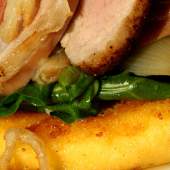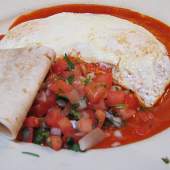Mediterranean

“One cannot think well, love well, sleep well, if one has not dined well.”
— Virginia Woolf
What comes to mind when you hear the word “Mediterranean?” For many of us, especially at this time of year as winter approaches, it undoubtedly translates to “a place we wish we were right now.” It’s sunny, warm, and exotic, with beautiful blue waters and scenic views — and fabulous food and wine. This week, in honor of Turquoise Café in Roscoe Village, one of tonight’s featured restaurants on Check, Please!, here’s a look at one of the oldest culinary traditions in world.
The area that borders the Mediterranean Sea, where Asia, Europe, and Africa intersect, involves quite a varied collection of countries, including Spain, Turkey, Greece, Italy, France, Algeria, Israel, Palestine, Lebanon, Morocco, Tunisia, Libya, Egypt, Syria, and others. That, obviously, is a lot of diversity! But there are a few culinary elements common to all…namely, the “holy trinity” of Mediterranean cooking:
- Olive Oil — This versatile condiment (a “healthy” fat) is one of the region’s more significant exports. You can cook quite well with regular refined olive oil, and save the extra-virgin, high quality, unrefined variety for dressing your salad and dipping your bread. (If you happen to have any of the regular stuff left over, you can rub it into your skin, hair, and furniture for its superior lubricating qualities!) The olives themselves, which grow on trees everywhere in this region, are great on their own, and not just in martinis. There’s nothing that says “Mediterranean” like a salad with fresh lettuce, feta cheese, and olives, served with…
- Bread — Wheat is probably the most prevalent crop grown in the Mediterranean basin, and much of it is used to make bread. Where you are in the region will, naturally, define the kind of breads you will find, which range from Greek and Middle Eastern pita; Italian focaccia and ciabatta; French baguette, croissant, and brioche; and bagels from Israel, among many others. Pita bread, of course, is used in gyros, falafel, and fattoush (salad). Anywhere you go, there will be a bread or breads particular to the region to accompany or form an integral part of your meal, along with…
- Wine — There’s no excuse for not enjoying a locally sourced wine while in the Mediterranean (a culinary tradition that goes all the way back to 6,000 BC). Due to the hospitable climate for grape-growing, each country is filled with wineries producing a product you probably won’t find (inexpensively, anyway) anywhere else. Whether you prefer red, white, rosé, sparkling — it’s readily available here, and it’s an important part of the meal. As with olive oil, wine is liberally used in recipes as well.
How about other elements? Meats are generally not the main part of a meal in the Mediterranean, but just one aspect of it, and they’re commonly grilled. Beef, due to limited grazing areas, is not found as often as lamb, mutton, pork, wild game, and chicken. Goat and sheep are prized not only for their meat but for their milk, which is used in cheeses and yogurt. Most popular is fresh seafood, especially calamari, scallops, mussels, and shrimp.
The climate lends itself extremely well to the cultivation of fresh herbs and vegetables, which can include anything from okra, tomatoes, artichokes, mushrooms, onions, cucumbers, squash, and a variety of lettuces and greens. These are served fresh in salads, and also roasted, baked, and grilled. Herbs grown in the region include oregano, rosemary, basil, dill, garlic, mint, cilantro, and thyme, just to name a few.
And dessert? Pick a country! Choices include Greek and Turkish baklava, Italian gelato and tiramisu, French éclairs and chocolate mousse, Spanish flan and churros, Israeli rugalach and babka, and many more. Your sweet tooth will not go unsatisfied, no matter where you go.
What you won’t find: a lot of frozen and processed items. Mediterranean food is best enjoyed close to where it was cultivated, harvested, and prepared, and is intended to make you feel refreshed and energized. It’s no surprise, then, that denizens of this region tend to live longer, healthier lives. A goal to which we can all aspire!





